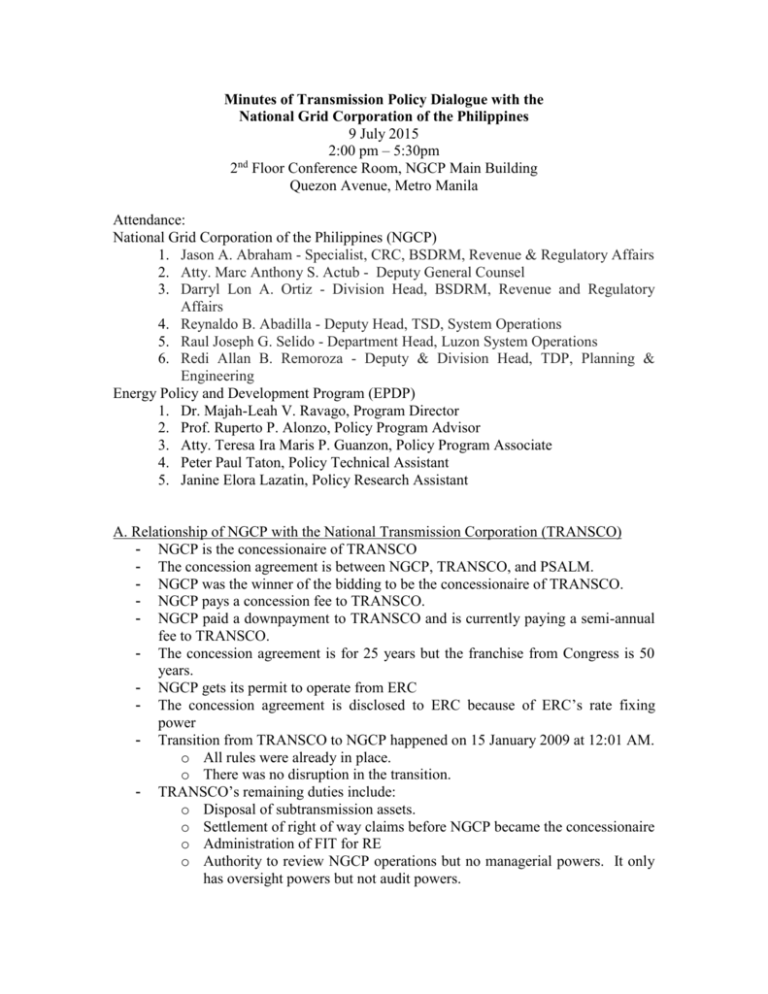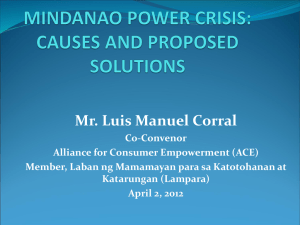Minutes of 9 July 2015 Meeting NGCP
advertisement

Minutes of Transmission Policy Dialogue with the National Grid Corporation of the Philippines 9 July 2015 2:00 pm – 5:30pm 2nd Floor Conference Room, NGCP Main Building Quezon Avenue, Metro Manila Attendance: National Grid Corporation of the Philippines (NGCP) 1. Jason A. Abraham - Specialist, CRC, BSDRM, Revenue & Regulatory Affairs 2. Atty. Marc Anthony S. Actub - Deputy General Counsel 3. Darryl Lon A. Ortiz - Division Head, BSDRM, Revenue and Regulatory Affairs 4. Reynaldo B. Abadilla - Deputy Head, TSD, System Operations 5. Raul Joseph G. Selido - Department Head, Luzon System Operations 6. Redi Allan B. Remoroza - Deputy & Division Head, TDP, Planning & Engineering Energy Policy and Development Program (EPDP) 1. Dr. Majah-Leah V. Ravago, Program Director 2. Prof. Ruperto P. Alonzo, Policy Program Advisor 3. Atty. Teresa Ira Maris P. Guanzon, Policy Program Associate 4. Peter Paul Taton, Policy Technical Assistant 5. Janine Elora Lazatin, Policy Research Assistant A. Relationship of NGCP with the National Transmission Corporation (TRANSCO) - NGCP is the concessionaire of TRANSCO - The concession agreement is between NGCP, TRANSCO, and PSALM. - NGCP was the winner of the bidding to be the concessionaire of TRANSCO. - NGCP pays a concession fee to TRANSCO. - NGCP paid a downpayment to TRANSCO and is currently paying a semi-annual fee to TRANSCO. - The concession agreement is for 25 years but the franchise from Congress is 50 years. - NGCP gets its permit to operate from ERC - The concession agreement is disclosed to ERC because of ERC’s rate fixing power - Transition from TRANSCO to NGCP happened on 15 January 2009 at 12:01 AM. o All rules were already in place. o There was no disruption in the transition. - TRANSCO’s remaining duties include: o Disposal of subtransmission assets. o Settlement of right of way claims before NGCP became the concessionaire o Administration of FIT for RE o Authority to review NGCP operations but no managerial powers. It only has oversight powers but not audit powers. - TRANSCO gets its funding from NGCP’s application with ERC The funding is for the settlement of right of way issues for transmission lines before NGCP became its concessionaire. TRANSCO initially pays to settle these issues, and it is reimbursed by NGCP NGCP has the responsibility to settle right of way issues for new lines NGCP has the power of eminent domain in its franchise B. The Transmission Development Plan (TDP) - The TDP is the ten-year plan of NGCP, and gives an overview of the existing grid. - It starts with inputs from DOE and the DUs specifically the system peak demand forecast and the generation additional line up. These are the main project drivers of the transmission facility. o DUs give their planning data in the form of the Distribution Development Plan to DOE. o DOE, in turn, makes its demand forecast. DOE uses a macro level system peak demand forecast. NGCP provides inputs to DOE since the former records the actual peak loads. o The Distribution Development Plan and the demand forecast serve as inputs to NGCP’s planning - NGCP conducts a separate forecast exercise. It uses a localized per substation forecast. Then it aggregates it. - Afterwards, NGCP does simulation and looks at the problems in the network plus the alternatives. o NGCP does simulations for contingency events by growing the load and checking the adequacy of the facilities. o During the simulations, NGCP evaluates the projections. o These are used for NGCP’s system impact studies. - Using all these inputs, NGCP then prepares the TDP. - The planning criteria for the TDP is based on the Philippine Grid Code (PGC) - The project line up will be contained in the draft TDP. - The draft TDP is presented to the DOE, TransCo, GMC, PEMC, DUs, GenCos, and other customers/stakeholders - The TDP Final Report is submitted to the DOE - The TDP is integrated into Philippine Energy Plan and the Power Development Plan. - The Power Development Plan contains the system peak demand forecast and the generation addition line up. - Installed capacity refers to the rated/design capacity while dependable capacity is the derated installed capacity. C. Overview of the Transmission Network (Grid) - The load distribution in the main grid is non-coincident. - Total demand in 2014 was 11,812 MW - As of 2014, the load distribution in the grid of the system peak demand is as follows: 74% Luzon, 14% Visayas, and 12% Mindanao. For Visayas and - - - Mindanao, the peak months are November to December, while for Luzon the peak is during the summer months. The annual average growth rate are as follows: Historical DOE Luzon 3.05% 4.37% Visayas 5.47% 5.48% Mindanao 2.36% 5.82% For Luzon, summer season drives the peak demand In Visayas and Mindanao, the peak demand is usually last quarter of the year The load centers are in Metro Manila, Cebu and Davao For the next ten years, Luzon and Mindanao’s load will increase. For Visayas it will be the same. The power flow depends on the dispatch schedule of the market. The dispatch schedule is based on optimization, and it takes the capacity of the facilities into consideration The generation capacity additions are private sector initiated power projects from 2014-2020. o These continue to depend on coal for energy requirements o There are committed and indicative projects. The committed projects are those with financing. o There are many proponents for power generation Existing Assets o Substation capacity – 30,606 MVA o Transmission lines – 19,463 circuit-km o Once the subtransmission lines are distributed to DUs, then the assets are subtracted from NGCP assets Highest transmission voltage – 500 kV 350 kV refers to link between Luzon and Visayas o Existing Interconnections Longest link: Leyte-Luzon Latest circuit connection: Panay-Boracay D. Luzon Grid - There’s a single circuit 230 kV transmission line to Metro Manila. - There have been no augmentation/new transmission lines since 1999. - The power corridor needs augmentation to ensure adequacy 15 to 20 years from now. It needs new transmission lines, new substations, and new double lines - The substations are heavily loaded. The immediate solution is to add transformers but we can only add up to a certain number depending on the substation - Another challenge is the space. - There is a limited number of delivery points. - Metro Manila accounts for 53% of the total load of the Luzon grid or about 40% of the total load of the country. - If we add the load of Quezon and Taytay, it’s greater than the load of Visayas - - - - - - The 500 kV expressway transmission backbone collects the bulk power from generators in the North and South of Luzon. They bring the power to San Jose and Dasmariñas (also known as drawdown substations) then this goes to Metro Manila. If the tower falls, then power will not be brought to Metro Manila. If the 500 kV breaks down from Sual the power will have to go through the 230 KV lines, which will significantly reduce transmitted power. This will be an opportunity loss for the power plants, since they will not be operating at maximum capacity We need a loop system for higher level of reliability. The loop is an alternate route. It will give flexibility and will accommodate more power generation. The areas with bulk generation additions include: o Bataan/Zambales (coal). Here, there is no readily available bulk backbone system o Batangas – has a lot of coal proposals o Quezon (expansion of Pagbilao) o Pangasinan (Masinloc) These areas with the bulk generation additions highlight the limitation of the drawdown substations. In Northern Luzon, there are plans to extend 230 kV loop The major grid developments to adequately and reliably serve the country’s load sector include: o The establishment of a 500 kV backbone loop system NGCP is considering lake-side developments since it cannot build within Metro Manila o The development of new transmission lines and new 500 kV and 230 kV substations in Metro Manila NGCP’s formal application for its tariff is every five years. In between if NGCP wants to extend its transmission lines, it needs ERC approval. ERC issues a provisional authority per project that NGCP applies for. There is a risk of no recovery. For the Batangas-Mindoro interconnection, NGCP is waiting for ERC approval ERC has approved the extension from Tuguegarao and Mahagapit NGCP is currently in discussion with the wind farms regarding line transmission Meralco is billed at the substations E. Visayas Grid - The transmission lines in the Visayas is project driven - There are a lot of coal plants in Panay but there’s one submarine cable only which is not enough to outsource the power from the coal plants - There are a lot of solar plants in Negros - A major development in the Visayas is the establishment of the Cebu-NegrosPanay 230 kV backbone. Another is the development of the Cebu-Bohol link. - Bohol’s demand load is high but there are no major power plant entering the area. Thus will loop Bohol to Cebu because there is a lot of generation in Cebu. - There is no right of way issues with submarine cables. - The challenge is that submarine cable projects are expensive F. Mindanao Grid - Relatively strong grid - It has a backbone system that is existing but energized at lower voltage levels - There is a need for 230 kV energization of the backbone – the Balo-I-VillanuevaMaramag-Bunawan transmission line - Mindanao is 50% hydro, but there are coal plants coming in, so NGCP expects a change in generation mix - There is also a need to extend the 230 kV transmission lines - Visayas-Mindano interconnection o The feasibility study for the Visayas-Mindano interconnection on the east side (Leyte-Surigao) was funded by JAICA, ADB. o The hydrographic survey showed there are a lot of hazards such as unexploded WWII ammunitions and underwater volcanoes. o Thus the area is not feasible for submarine cables. o NGCP is now looking at the possibility of connecting Visayas and Mindanao via the western route – Negros, Cebu, and Zamboanga. o The feasibility study by NGCP is currently being undertaken. o The connection is needed to export excess power. o The driver of the interconnection is to unify the market. G. NGCP operations - NGCP does internal cash generation and funds its own projects. Its recovery of investment is through ERC - The window to get approval of tariff is once every 5years. It has to submit its proposed allowable revenue. The proposal includes capital investment, return of capital, operation and maintenance costs, etc. - The problem is the timing issue. - NGCP funds investment even without recovery. - Right now there are 20 projects being implements but these were not included in the first tariff application. - ERC caps NGCP’s revenue (vs. DU’s whose price is capped) - ERC gives NGCP the cost of money for investing - ERC computes cost then the rate impact - ERC takes about 1 year from submission to provisionally approve projects - The recovery is based on demand - NGCP can’t be pro-active as much as it wants to because it is subject to optimization of ERC. - NGCP cannot really take action unless approved by ERC - While NGCP wants to reinforce the grid to make it at par, when ERC says not to do anything, NGCP can only cater to investments as it sees the demand growing. - ERC looks at the tariff impact or rate impact because of the recovery. - The priority is capacity addition - The bottomline is the tariffs incorporate fixed costs and variable costs - - - We have a shallow connection charging policy where although generators pay for connecting to NGCP’s grid, the other costs associated with the project (i.e. externalities on capacity of the grid) are not paid by the generators. Instead, consumers pay the transmission charge. NGCP proposed that generators and consumers pay for the transmission charge so as to provide a market signal where to locate. This is unlike the deep connection charging policy in other jurisdictions such as the US and Europe. Centralized planning is also a problem NGCP has identified ideal locations but it is still the power plant that decides. The locations identified point to the readiness of the grid and not the areas friendly to specific power plants. For example, areas that are friendly to coal (near the sea) are already congested. What’s ideal for NGCP is not ideal for power plants. Power plants do not absorb cost imposed on the system. If ERC charges power plants with wheeling charges, it will just pass it on to consumers. Another problem encountered by NGCP is generator proponents who do not disclose their maximum capacity A lot of timing and coordination issues ERC approval is based on necessity and impact on rate H. NGCP as the System Operator - Typical load curve o Luzon Demand usually peaks on summer season. The main drivers are the air-conditioning unit and industries. Luzon has three peaks - the morning peak at 11am, the afternoon peak at 2pm, and the evening peak at 7pm. Most plants are coal o Visayas In the Visayas, the natural trend is increasing. In December 2013, the demand in the Visayas demand dropped because of typhoon Yolanda. Visayas was only able to recover in April 2014. All plants in the Visayas are fully contracted. Prices in Visayas are cheaper The flow is usually from Visayas to Luzon o Mindanao In Mindanao, the summer peak demand is not as high compared to November and December. The demand peaks during the last quarter. The bulk is from hydro - NGCP is the system operator. - It provides central dispatch to all in accordance with the dispatch schedule submitted by the market operator. - - Data on the power direction and flow is available to NGCP To “dispatch” means to increase/decrease the MW delivery The dispatch happens on an hour basis NGCP as the system operator orchestrates or polices the system Power dispatch process o 1. NGCP gives system updates/data to the market operator – PEMC. o 2. The trading participants/generators will then market updates in the form of bids and offers. o 3. PEMC will afterwards make the dispatch schedule of generators. The dispatch schedule takes the market into consideration The market operator makes use of the real time data of the system operator and the offers of the power plants o 4. NGCP then gives the pre-dispatch instructions There is a priority list for the dispatch schedule The cheapest offer is dispatched first. The must dispatch are wind, solar, and run-off river For the FIT eligible industries, there is no offering of price since they’re must dispatch o 5. Trading participants/generators then give compliance monitoring NGCP has day ahead projections There is one regional control center and one back up regional control center each in Luzon, Visayas, and Mindanao. There are also area control centers in each geographic region. The regional control centers monitor the 230 kV and above transmission lines while the area control centers monitor the 69 kV and below transmission lines. There are also manual local controls in substations Frequency Control o The system operator is responsible for ensuring the balance of load and generation is balanced o Load must equal generation o Hertz indicate the balance of supply and demand o If there is a balance between supply and demand, the system frequency is at 60 Hz. There is an oversupply if greater than 60 Hz There is excess demand if less than 60 Hz o The system operator shall maintain the fundamental frequency within the limits of 59.4 Hz and 60.6Hz. This is the range of the normal frequency. o The system operator shall intervene when the frequency limits of 59.7hz and 60.3 hz are breached to bring back the frequency to 60 Hz. o Overfrequency has effects on home appliances. o For underfrequency, NGCP uses regulating reserves specifically the contingency and dispatchable reserves o The use of the regulating reserves is automatic. o NGCP contracts power plants to provide regulating reserve - - - - - o The contract between NGCP and the power plant is similar to a power supply agreement. It is similar to the peaking requirements of DUs. When the need arises, the reserve should be there. o Whenever there’s a brown out, there is either excess demand or under supply o Every two seconds that the frequency is not within the + or - 60 Hz, NGCP will have a frequency limit violation (FLV). An FLV is penalized by ERC. o NGCP is being graded by ERC. They have a stake to make the frequency as close as possible to 60Hz Voltage Control o Voltage must also be within the band o NGCP ensures that + or - 10% voltage. o 230 kV + or - 5% is still considered normal o + 10% is overvoltage while – 10% is undervoltage o If breaches + or - 5% of the nominal voltage, this is considered as 1 voltage limit violation (VLV) Automatic Load Dropping (ALD) o ALD is pre-programmed. o There are groupings , and the groupings are rotated. o Usually if there’s ALD, the black out only lasts for 8 to 15 minutes Manual Load Dropping (MLD) o After ALD, MLD proceeds if supply is still not enough o 1 to 100 MW experience 1 hour rotating brownout o Usually, 30% is dropped from NGCP while 70% is dropped from Meralco o Meralco has an internal interruptible load program which they can choose to shut down during MLD NGCP has three reserves o Regulating reserve – automatically kicks in o Contingency reserve – on top of regulating reserve, NGCP must have reserve equal to the highest unit online (which is Sual) at that hour. This serves as the back up in case the regulating reserve trips. o Dispatchable reserve – must equal the second highest unit online Sual I and II are the highest and second highest unit online Normal State – have all reserves available Yellow Alert – dispatchable reserve is depleted Red Alert – contingency reserve is also depleted Only have regulating reserve and consumer demand left Ancillary Scheduling Process o 1. Nomination – power plants nominate to NGCP The contingency is the power plant with the highest unit online The dispatchable reserve is the power plants with second highest unit online. The ancillary cannot release whatever is reserved for NGCP o 2. Scheduling o 3. Dispatch implementation - - o 4. Re-nomination/re-scheduling o 5. Compliance Monitoring o 6. Billing Statement Grid Operating States o Nomination – scheduling – dispatch implementation – re-nomination/rescheduling – compliance monitoring – billing statement o NGCP/Ancillary – ancillary cannot release whatever is reserved for NGCP Alert notices o Blue alert notice – tropical cyclone is expected to make landfall within 24 hours I. Renewable Energy (RE) - RE only entered late last year and early this year - RE is concentrated in Luzon and Visayas o Luzon – 3.6% penetration (Laoag wind farms) Wind – 282 MW Solar – 40 MW (Majestic in Cavite) o Visayas – 9.2% penetration Wind – 104 MW Solar – 43.8 MW (Negros - In Northern Luzon, NGCP implemented a new transmission line with enough capacity so they can connect physically, - Each power plant submits an application for physical connection to NGCP. NGCP conducts a system impact study so as to determine the connection point and what can be done so that the grid can accommodate the new capacity. - All RE pass through the system impact study so NGCP knows the limitation of the system and what to do to address that - The problem is the timeline of RE. It is aggressive. It undergoes rapid development in contrast to building transmission lines which require time. NGCP cannot cope with the pace of the RE plants. - If the connection is a “dedicated” connection then the power plants have to take care of the connection from the power plant to the nearest line of NGCP. An example is the wind power plants in Laoag. - FIT includes the cost of connection of the RE plants to the grid. - If the connection is a “shared” connection, then NGCP takes care of the connection line. - How does NGCP evaluate a connection of a power plant to the grid? It first looks at the MW capacity of the plant. Then, it informs the power plant of the time to implement the necessary adjustments to the lines and to the grid as well as the requirements for the power plant to be connected to the grid. However, all these are still subject to prior ERC approval. The procedure is as follows: o Issuance of DOE notice for NGCP to proceed with the system impact study. This certificate is given by the power plants to NGCP. o NGCP does planning on the necessary augmentation on the grid o NGCP issues a final decision o NGCP undergoes a facility study - - o Connection agreement between the power plant and NGCP NGCP has never said no to a power plant Increased frequency of RE will lead to greater generation Decreased frequency of RE will lead to greater demand There are RE system impact studies being done by the NGCP’s planning department. NGCP is also assessing the operational impact of RE since the costs aren’t quantifiable yet due to the low supply. The impact of RE is really on the frequency. The entry of RE has increased the number of FLV. The weather has an impact on the generation of RE (especially from sunny to cloudy) For solar, you can control increasing generation (there’s a regulating mechanism) but not so much the decrease in generation since it’s very dependent on radiance. This may not be a problem of the location of solar power generators are spread out rather than concentrated. For wind, there are also problems. Plants try to optimize at certain months when it’s windy. Challenges and Concerns o An issue with RE is its variability o 1. Stability As RE increases, it is decoupled from the grid unlike conventional power which has inertia. RE’s connection is through inverters. These are detached from the grid and does not help the strength of the system. As RE increases, frequency is affected, more ALD groups are activated. The reserve requirement cannot cope. FLV becomes more active Now, the FLV is controllable because NGCP tries to manage the grid The operations of NGCP is currently studying the issues contributing to the increase in the FLV FLVs significantly increase for the past four months compared to 2014. A comprehensive assessment is still going on to identify the root cause. One possibility is the effect of the variability of RE in the Visayas. o 2. Ancillary Service Ancillary services are sourced from conventional power plants. Before RE, the ancillary services are used to balance generation and demand. Now with RE, the ancillary services have to cope with variability of generation. The grid experiences the variability of RE because incorporating RE increases the load variability. An increase in the reserve to address the variability of RE entails additional costs. o 3. Forecasting This is one of the important requirements when it comes to RE It dictates how much reserve will be required and how much from the conventional power plants will be stocked up Experts say that as RE increases, the variability is stabilized. They also say that solar and wind power tend to be complementary The FLV in 2014 (pre RE) was 81,811. The FLV in 2015 (with RE) was 139,811. There was a 41.48% increase. NGCP is studying why this happened. The tolerance of the grid for variability is also being studied. There is also a question of whether to increase the reserve requirement. RE is required to submit its forecast to NGCP. If the forecast is greater than the actual, the effects will be felt on the regulating, contingency, dispatchable, and must run reserves. These will all be utilized. These could result in ALD or MLD. If the forecast is less than the actual, the effect would include constraining off generators in the highest rank of offers. o Actions taken by NGCP Coordination of ancillary service providers specially regulating the reserve providers to ensure that ample amount of reserve is available and operational to accommodate the fluctuations brought about by RE. Be more vigilant to balance the grid dispatch, and to see to it that the Frequency Limit Compliance is met. Improvement of automatic generation control system to see to it that secondary frequency response is appropriately provided. High Voltage Direct Current (HVDC) frequency control upgraded. The HVDC can now regulate the system frequency in Visayas both in forward (Visayas going to Luzon) and reserve flow (Luzon going to Visayas) Ongoing recording of data Ongoing studies on Reserve adequacy analysis Inertia and frequency response Ongoing coordination with international organizations such as NREL, USAID, USEA, and GIZ o Policy direction In other jurisdictions, they are able to touch RE generation in that they can control RE at all times. They are able to balance RE to accommodate more if the security and reliability of the grid is affected. According to the Philippine Grid Code, NGCP can control if there’s an agreement with RE but RE plants do not want to be controlled. o Way forward Coordinate with other jurisdictions in terms of forecasting tools Develop in-house expertise in power forecasting MOA to decrease trading intervals from one hour to every 30 minutes or 5 minutes in 2018. Expand the balancing footprint Broader balancing areas and geographic diversity can reduce variability and the need for reserves Flexible generation from wind If you can control RE, then there will be flexibility to accommodate more power from RE Wind can provide synthetic inertia control and primary and secondary frequency response Capability to curtail to a set-point command during periods of system stress Other jurisdictions say that factors may be different. NGCP can compare with Hawaii but there could still be other factors. Several regions in the US and elsewhere are beginning to mandate faster dispatch to reduce expensive reserves o Other Issues Cost implication Upgrading of grid Policy implication of grid NGCP wants to implement everything now so that prepared but limited by demand and ERC’s optimization There’s a policy gap since RE should help in stabilizing the system.







